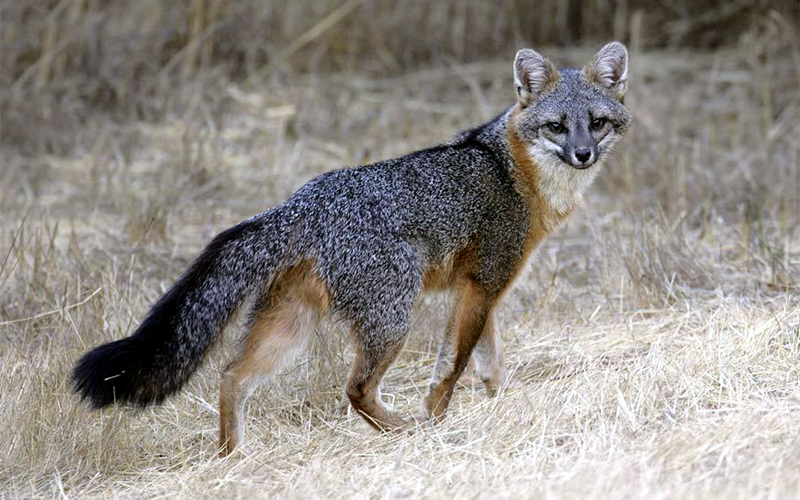Post by Ceratodromeus on Nov 23, 2016 3:44:22 GMT 5
Gray fox (Urocyon cinereoargenteus)

"The gray fox is mainly distinguished from most other canids by its grizzled upper parts, black-tipped tail and strong neck, while the skull can be easily distinguished from all other North American canids by its widely separated temporal ridges that form a U-shape. There is little sexual dimorphism, save for the females being slightly smaller than males. The gray fox ranges from 76 to 112.5 cm (29.9 to 44.3 in) in total length. The tail measures 27.5 to 44.3 cm (10.8 to 17.4 in) of that length and its hind feet measure 100 to 150 mm (3.9 to 5.9 in). The gray fox typically weighs 3.6 to 7 kg (7.9 to 15.4 lb), though exceptionally can weigh as much as 9 kg (20 lb). It is readily differentiated from the red fox by the lack of "black stockings" that stand out on the latter and the stripe of black hair that runs along the middle of the tail. In contrast to all Vulpes and related (Arctic and fennec) foxes, the gray fox has oval (instead of slit-like) pupils."
en.wikipedia.org/wiki/Gray_fox
Timber rattlesnake (Crotalus horridus)

"Adults usually grow to total length of 91–152 cm (36–60 in). It was found in Pennsylvania that the smallest size females could produce viable eggs was 72.2 cm (28.4 in). Most adult timber rattlesnakes found measure less than 100 to 115 cm (39 to 45 in) in total length and weigh on average between 500 and 1,500 g (1.1 and 3.3 lb), often being towards the lower end of that weight range. The maximum reported total length is 189.2 cm (74.5 in) (Klauber, 1956). Holt (1924) mentions a large specimen caught in Montgomery County, Alabama, which had a total length of 159 cm (62.5 in) and weighed 2.5 kg (5.5 lb). Large specimens can reportedly weigh as much as 4.5 kg (9.9 lb)."
en.wikipedia.org/wiki/Crotalus_horridus

"The gray fox is mainly distinguished from most other canids by its grizzled upper parts, black-tipped tail and strong neck, while the skull can be easily distinguished from all other North American canids by its widely separated temporal ridges that form a U-shape. There is little sexual dimorphism, save for the females being slightly smaller than males. The gray fox ranges from 76 to 112.5 cm (29.9 to 44.3 in) in total length. The tail measures 27.5 to 44.3 cm (10.8 to 17.4 in) of that length and its hind feet measure 100 to 150 mm (3.9 to 5.9 in). The gray fox typically weighs 3.6 to 7 kg (7.9 to 15.4 lb), though exceptionally can weigh as much as 9 kg (20 lb). It is readily differentiated from the red fox by the lack of "black stockings" that stand out on the latter and the stripe of black hair that runs along the middle of the tail. In contrast to all Vulpes and related (Arctic and fennec) foxes, the gray fox has oval (instead of slit-like) pupils."
en.wikipedia.org/wiki/Gray_fox
Timber rattlesnake (Crotalus horridus)

"Adults usually grow to total length of 91–152 cm (36–60 in). It was found in Pennsylvania that the smallest size females could produce viable eggs was 72.2 cm (28.4 in). Most adult timber rattlesnakes found measure less than 100 to 115 cm (39 to 45 in) in total length and weigh on average between 500 and 1,500 g (1.1 and 3.3 lb), often being towards the lower end of that weight range. The maximum reported total length is 189.2 cm (74.5 in) (Klauber, 1956). Holt (1924) mentions a large specimen caught in Montgomery County, Alabama, which had a total length of 159 cm (62.5 in) and weighed 2.5 kg (5.5 lb). Large specimens can reportedly weigh as much as 4.5 kg (9.9 lb)."
en.wikipedia.org/wiki/Crotalus_horridus







